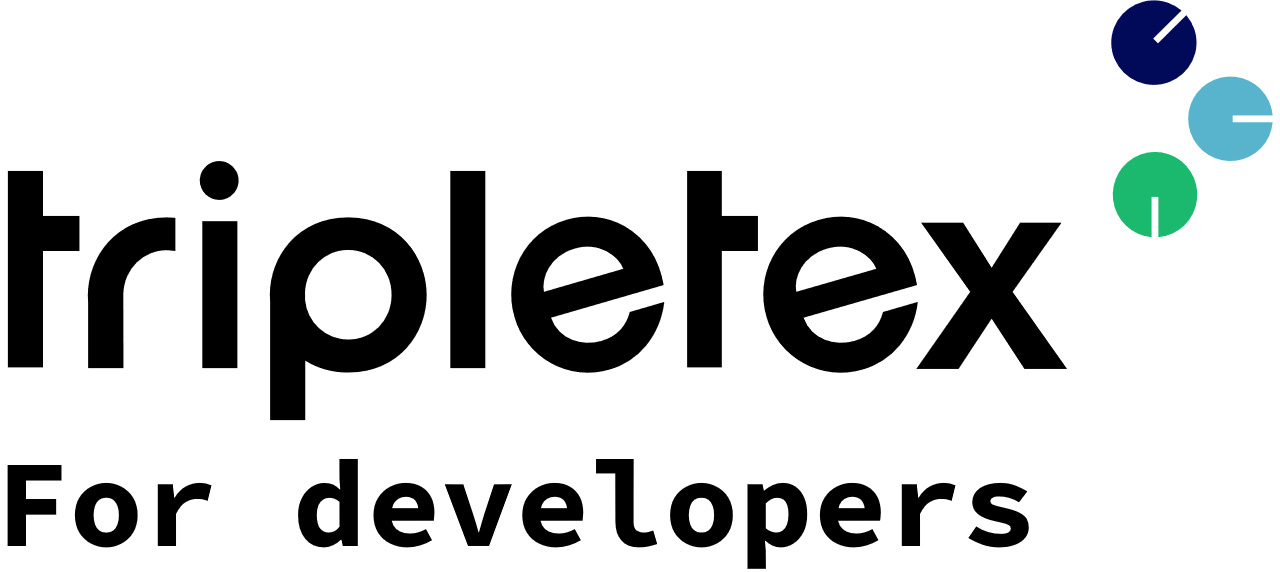Authentication is done via Basic access authentication.
- Username is used to specify what company to access.
- 0 (zero) or blank means the company of the employee, employee here meaning the owner of the employee token.
- Any other value for user name means accountant clients. Use /company/>withLoginAccess to get a list of those. More info about these tokens can be found here.
- Password is the sessionToken.
In Tripletex you authenticate using two tokens to create a session token. These two tokens are employee tokens and consumer tokens. For the test environment at api.tripletex.io you will be given both tokens as well as login credentials once you sign up, for production you need to apply for access. The consumer token for production is given to each developer once you are approved via email together with your application name within Tripletex. You will use the same token for each end user of the integration.
Please note:
Credentials/tokens for test (api.tripletex.io) will not work in production (tripletex.no), and vice versa.
The employee token is created by the end user within the GUI and can be either a regular employee token or an accountants employee token. The latter requires some extra steps for authentication, please see further down in this article for information about this.
For your customer to create a regular employee token they log in, activate the integrations-service if they have not already, and then head to the API-access tab for the user they want to own the token.

From here they click “New token”. If you have submitted an access template to us then your integration will be available from the application dropdown, the end user only has to select your integration, give it a name to associate with the token and click “Create token”.

If your integration is not available in the dropdown, then you need to provide the end user with your application name, the user then clicks “Adapted setup”, and enters it in the application name field (case sensitive).

For adapted setup the user also decides to give the token all entitlements, the same entitlements as the owner or no entitlements, these can always be tweaked later on. If the end-user sets “All entitlements” on a token owned by a user that does not have all entitlements on their account, these will be activated but greyed out like so in the tokens entitlement list.
Any entitlement given to the token but not the owner will be disabled.
For both setups the user gives the token a unique name that they will recognise in the last field. End users can find a how-to article here: https://hjelp.tripletex.no/hc/no/articles/4409557117713
When the token is created it will appear once in a dialogue popup:

If the user misplaces this they can generate a new token for the same integration, this invalidates the previous token.

The user can also click on the token name to adjust entitlements. Note that an employee token can not have an entitlement that the owner does not have.
Once you have both your consumer and an employee token you are ready to authenticate towards the API. We will be using Postman in this example.
First we will make a request to PUT token/session/:create, here we will pass my consumer and employee token as well as an expiration date. For this example we have set the expiration date to tomorrow’s date via a variable, but you are free to set your own. The token will expire when the server time (CET) crosses midnight and the date changes to the one provided here.

In the response you receive our session token. This token is what you use in the authentication header.

Tip: You can assign the value of this response to a variable with the following test:

var jsonData = JSON.parse(responseBody);
postman.setEnvironmentVariable("token", jsonData.value.token);For the authentication settings we enter username 0 and set the password to be the session token. Then set authentication to Basic auth in Postman. Now when you create any new requests in this collection, set them to inherit this auth, and this means we are ready to make requests toward this Tripletex account.

As mentioned earlier we have two different kinds of employee tokens. The second kind is an accountant token. To explain this we first have to briefly describe the accountant access feature in Tripletex.
In Tripletex any given accountant that has access to Tripletex for their accounting office also has the possibility to create client access via their Tripletex account to their clients. This is done so that their clients won’t need to create individual user accounts for the accountant offices staff in each company.
Once client access is established the user admin of the accounting office adds their users to the client and assigns entitlements to them through their client access settings. If they create an accountant token this works the same way, once it is created it must also be added to each client the token should have access to and be assigned entitlements. The accountant token does not have access to any data within the accounting office’s account.
For the authentication this changes a few things. We still create a session token like before, but we can not use 0 as the username for any requests other than GET company/>withLoginAccess and GET token/session/>whoAmI. To be able to run any requests to the client account we have to run GET /company/>withLoginAccess. This will return a list of all clients that the token has been given access to. From here we then use the client’s ID from this list as a username in future requests, so if I want to access this company I will need to use the ID found here as the username, followed by my session token as the password. After this we can perform API calls like usual.
